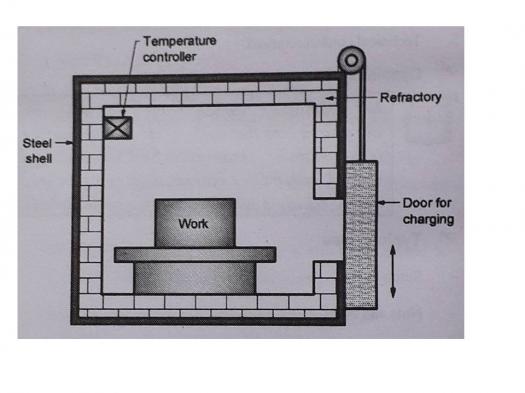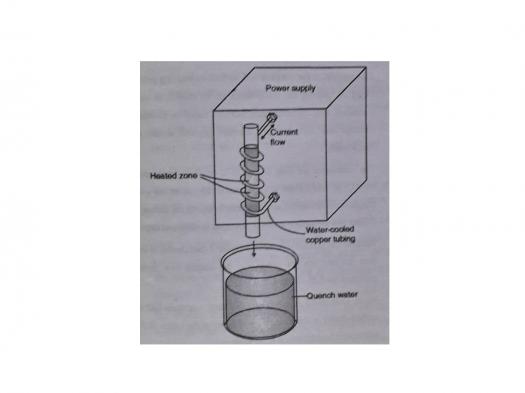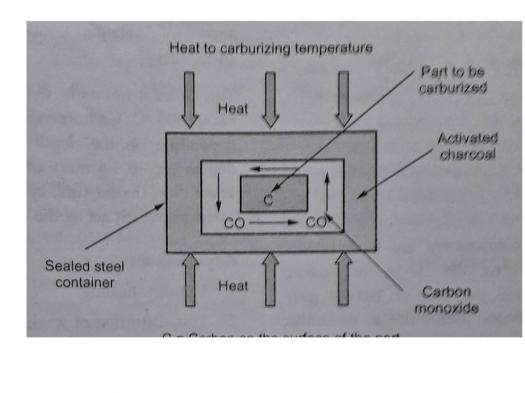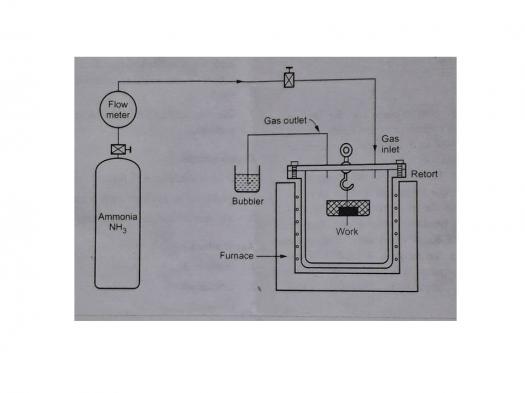Mem- Heat Treatment Practice Test

Dear Students please take this test as a practice for Heat Treatment Chapter.
- 1.
Rapid quenching can be obtained by cooling in______________
- A.
Air
- B.
oil
- C.
Water
- D.
Brine
Correct Answer
D. BrineExplanation
Rapid quenching refers to the process of cooling a material quickly in order to achieve certain desired properties, such as increased hardness or improved strength. The options given for cooling mediums are air, oil, water, and brine. While air and oil can be used for cooling, they do not provide as rapid of a quenching rate as water or brine. Water is a common cooling medium used for rapid quenching, but brine, which is a solution of salt in water, can provide an even faster quenching rate due to the lower freezing point and higher heat transfer capacity of the salt solution. Therefore, brine is the correct answer for obtaining rapid quenching.Rate this question:
-
- 2.
A steel piece after hardening is heated to 300 degree celsius and then cooled in oil. The property imparted to the steel piece will be
- A.
Softness
- B.
Toughness
- C.
Hardness
- D.
Annealing
Correct Answer
B. ToughnessExplanation
When a steel piece is heated to a high temperature and then cooled rapidly in oil, it undergoes a process called quenching. This process increases the hardness and strength of the steel, making it tougher. Toughness refers to the ability of a material to withstand impact and resist fracture. Therefore, the property imparted to the steel piece after quenching is toughness.Rate this question:
-
- 3.
Annealing is done
- A.
To harden the surface
- B.
For surface smoothness
- C.
For relieving stresses
- D.
To improve microstructure for good surface finish
Correct Answer
C. For relieving stressesExplanation
Annealing is a heat treatment process used to relieve stresses in a material. During annealing, the material is heated to a specific temperature and then slowly cooled. This process helps to reduce internal stresses that may have been caused by previous manufacturing processes such as casting or machining. By relieving these stresses, the material becomes more stable and less prone to distortion or failure. Therefore, the correct answer is "for relieving stresses."Rate this question:
-
- 4.
Slowest cooling rate is obtained when steel is quenched in ____________
- A.
Air
- B.
brine
- C.
fused salt
- D.
Water
Correct Answer
A. AirExplanation
When steel is quenched in air, the cooling rate is the slowest compared to quenching in brine, fused salt, or water. This is because air has lower thermal conductivity compared to the other options, which means that it is less efficient in transferring heat away from the steel. As a result, the steel cools down at a slower rate when quenched in air.Rate this question:
-
- 5.
The effect of austenitic grain size development during heat treatment is
- A.
Lower internal stress
- B.
Greater toughness
- C.
Lower hardenability
- D.
All of the above
Correct Answer
B. Greater toughnessExplanation
During heat treatment, the development of austenitic grain size has an effect on the material's properties. A larger grain size leads to lower internal stress, which can improve the toughness of the material. This is because larger grains provide more room for dislocations to move, reducing the likelihood of crack propagation. On the other hand, smaller grain sizes can increase hardenability, which refers to the material's ability to be hardened through heat treatment. Therefore, the correct answer is that the development of austenitic grain size during heat treatment results in greater toughness.Rate this question:
-
- 6.
Hardness and tensile strength in austenite stainless steel can be increased by
- A.
Hardening and cold working
- B.
Normalizing
- C.
Martempering
- D.
Full annealing
Correct Answer
A. Hardening and cold workingExplanation
Hardening and cold working can increase the hardness and tensile strength in austenite stainless steel. Hardening involves heating the steel to a high temperature and then rapidly cooling it, which helps to increase its strength. Cold working, on the other hand, involves deforming the steel at room temperature, which can also enhance its strength. Normalizing, martempering, and full annealing do not have the same effect on increasing hardness and tensile strength in austenite stainless steel.Rate this question:
-
- 7.
During dielectric heating the heat is generated primarily due to _____________
- A.
Due to molecular friction resulting from oscillating molecules and ions caused by the applied alternating electric field.
- B.
Option 2
- C.
Option 3
- D.
Option 4
Correct Answer
A. Due to molecular friction resulting from oscillating molecules and ions caused by the applied alternating electric field.Explanation
During dielectric heating, the heat is generated primarily due to molecular friction resulting from oscillating molecules and ions caused by the applied alternating electric field. This means that when an alternating electric field is applied to a dielectric material, the molecules and ions in the material start to oscillate. These oscillations cause friction between the molecules and ions, which in turn generates heat. This phenomenon is the main reason for the heat generation during dielectric heating.Rate this question:
-
- 8.
Carbon percentage in steel for carburizing is usually ______
- A.
0.1-0.2%
- B.
0.2-0.35%
- C.
0.4-0.6%
- D.
0.7-0.9%
Correct Answer
A. 0.1-0.2%Explanation
The carbon percentage in steel for carburizing is usually 0.1-0.2%. This range is ideal for carburizing, a heat treatment process that introduces carbon into the surface of the steel to increase its hardness and wear resistance. Higher carbon percentages, such as 0.4-0.6% or 0.7-0.9%, may be used for other purposes, but for carburizing, a lower carbon content is preferred to achieve the desired results.Rate this question:
-
- 9.
In which process steel is heated below the critical temperature___________
- A.
Sub-critical annealing
- B.
Full annealing
- C.
Stress releiving
- D.
Spherodizing annealing
Correct Answer
A. Sub-critical annealingExplanation
Sub-critical annealing is the process in which steel is heated below its critical temperature. This process is used to reduce the hardness and brittleness of the steel, making it more malleable and easier to work with. By heating the steel below its critical temperature, the microstructure of the steel is not significantly changed, allowing it to retain its original properties while becoming more ductile. This process is often used in the manufacturing of steel components that require a combination of strength and flexibility.Rate this question:
-
- 10.
Annealing improves_________
- A.
Grain size
- B.
Mechanical properties
- C.
Electrical properties
- D.
All of above
Correct Answer
D. All of aboveExplanation
Annealing is a heat treatment process that involves heating a material, such as metal or glass, to a specific temperature and then cooling it slowly. This process helps in improving various properties of the material. By annealing, the grain size of the material can be controlled and refined, leading to improved mechanical properties such as increased strength and ductility. Additionally, annealing can also enhance the electrical properties of certain materials, such as conductivity. Therefore, the correct answer is "All of above" as annealing can improve grain size, mechanical properties, and electrical properties.Rate this question:
-
- 11.
Austempering is the heat treatment process used to obtain greater________
- A.
Hardness
- B.
Toughness
- C.
Brittleness
- D.
Ductility
Correct Answer
B. ToughnessExplanation
Austempering is a heat treatment process that involves quenching a material to a temperature just above its martensitic transformation temperature and then holding it at that temperature until the desired transformation occurs. This process is known to produce a microstructure that provides a good balance between hardness and toughness. Therefore, the correct answer is toughness.Rate this question:
-
- 12.
Spherodise annealing used to produce spheroidal or globular form of __________________ from plates of cementite in steel
- A.
Carbide in ferrite
- B.
Option 2
- C.
Option 3
- D.
Option 4
Correct Answer
A. Carbide in ferriteExplanation
Spherodise annealing is a heat treatment process used to convert the carbide phase in steel into a spheroidal or globular form. This process involves heating the steel to a specific temperature and holding it there for a certain period of time, which allows the carbide particles to transform into a more rounded shape. The result is a steel microstructure with improved ductility and toughness, as the spheroidal carbides are less prone to cracking and fracture compared to their original plate-like form. Therefore, the correct answer is "carbide in ferrite."Rate this question:
-
- 13.
Which of the following hardening process is generally used for non-ferous materials?
- A.
Cyaniding
- B.
Flame hardening
- C.
Pack carburizing
- D.
Age hardening
Correct Answer
D. Age hardeningExplanation
Age hardening is a hardening process that is generally used for non-ferrous materials. It involves heating the material to a specific temperature and holding it there for a certain period of time, followed by a rapid cooling process. This process allows for the precipitation of fine particles within the material, which increases its strength and hardness. Age hardening is commonly used for non-ferrous alloys such as aluminum, magnesium, and copper.Rate this question:
-
- 14.
Killed steel is___________
- A.
Steel which has been shaped on a power hammer
- B.
Steel with less than normal percentage of carbon
- C.
Steel that has lost its properties due to excessive alloying
- D.
That steel which is deoxidised in the ladle with silicon and aluminium
Correct Answer
D. That steel which is deoxidised in the ladle with silicon and aluminiumExplanation
Killed steel refers to steel that is deoxidized in the ladle with the addition of silicon and aluminum. Deoxidizing the steel helps to remove impurities and gases, resulting in a more uniform and homogeneous steel with improved properties. This process helps to eliminate porosity and improve the overall quality of the steel.Rate this question:
-
- 15.
The process of reheating the martenstic steel to reduce its brittleness without any significant loss in its hardness is ___________
- A.
Normalizing
- B.
Annealing
- C.
Quenching
- D.
Tempering
Correct Answer
A. NormalizingExplanation
Normalizing is the process of heating the martensitic steel to a temperature slightly above its critical temperature and then allowing it to cool in still air. This process helps to reduce the brittleness of the steel without significantly affecting its hardness. It also helps to refine the grain structure of the steel, making it more uniform and improving its overall mechanical properties. Annealing involves heating the steel to a high temperature and then slowly cooling it, while quenching involves rapidly cooling the steel to increase its hardness. Tempering involves reheating the steel to a specific temperature and then cooling it slowly to reduce its hardness and increase its toughness.Rate this question:
-
- 16.
In stress relief annealing, steel is heated to a temperature between ______
- A.
200⁰C to 250⁰C
- B.
300⁰C to 325⁰C
- C.
385⁰C to 440⁰C
- D.
500⁰C to 550⁰C
Correct Answer
D. 500⁰C to 550⁰C -
- 17.
Hardenability of a material can be measured using __________ test.
- A.
Jominy end-quench
- B.
Charpy
- C.
Rockwell
- D.
Izod
Correct Answer
A. Jominy end-quenchExplanation
The correct answer is Jominy end-quench. Jominy end-quench test is a method used to measure the hardenability of a material, which refers to its ability to be hardened through heat treatment. This test involves heating a cylindrical specimen and then quenching it at one end, while the other end is allowed to cool slowly. The resulting hardness profile along the length of the specimen provides information about the material's hardenability.Rate this question:
-
- 18.
In stress relief annealing, steel is heated to a temperature between ______
- A.
200⁰C to 250⁰C
- B.
300⁰C to 325⁰C
- C.
385⁰C to 440⁰C
- D.
500⁰C to 550⁰C
Correct Answer
D. 500⁰C to 550⁰C -
- 19.
During dielectric heating the heat is generated primarily due to _____________
- A.
Eddy currents
- B.
Stray magnetic fields
- C.
High voltage
- D.
High power consumption
Correct Answer
A. Eddy currentsExplanation
During dielectric heating, the heat is generated primarily due to eddy currents. Eddy currents are circular currents that are induced in a conductor when it is placed in a changing magnetic field. These currents circulate within the conductor, causing resistance and generating heat. In dielectric heating, the changing magnetic field is produced by high-frequency electromagnetic waves, which induce the eddy currents in the material being heated. As a result, the material heats up due to the resistance of the eddy currents flowing through it.Rate this question:
-
- 20.
Identify the type of furnace.
- A.
Box type
- B.
Muffle type
- C.
Open hearth
- D.
Blast type
Correct Answer
B. Muffle typeExplanation
The correct answer is "Muffle type". A muffle furnace is a type of furnace that has a separate chamber, called a muffle, which surrounds the material being heated. This chamber helps to protect the material from direct contact with the flame or heating elements, ensuring a more controlled and uniform heating process. Muffle furnaces are commonly used in laboratories and industries for applications that require precise temperature control and protection of the sample from contamination.Rate this question:
-
- 21.
Identify the type of furnace.
- A.
Box type
- B.
Muffle type
- C.
Open hearth
- D.
Blast type
Correct Answer
A. Box typeExplanation
The correct answer is "Box type" because this type of furnace is enclosed in a box-like structure, which allows for better control of temperature and atmosphere inside the furnace. It is commonly used for heat treating, annealing, and other similar processes.Rate this question:
-
- 22.
Identify the type of heat treatment process
- A.
Flame hardening
- B.
Induction hardening
- C.
Carburizing
- D.
Nitriding
Correct Answer
B. Induction hardeningExplanation
Induction hardening is a type of heat treatment process where a metal object is heated using an electromagnetic field and then rapidly cooled. This process is used to increase the hardness and wear resistance of the metal surface while maintaining the toughness of the core. It is commonly used for hardening gears, shafts, and other components that require high strength and durability. Flame hardening, carburizing, and nitriding are also heat treatment processes, but they involve different techniques and produce different results compared to induction hardening.Rate this question:
-
- 23.
Identify the type of heat treatment process
- A.
Flame hardening
- B.
Induction hardening
- C.
Pack Carburizing
- D.
Nitriding
Correct Answer
C. Pack CarburizingExplanation
Pack carburizing is a type of heat treatment process where the object to be treated is packed in a carbon-rich material, such as charcoal or carbon powder, and heated in a furnace. This process allows carbon atoms to diffuse into the surface of the object, increasing its hardness. It is commonly used to improve the wear resistance of steel components. Flame hardening, induction hardening, and nitriding are also heat treatment processes, but they involve different techniques and produce different effects on the material being treated.Rate this question:
-
- 24.
Identify the type of heat treatment process
- A.
Flame hardening
- B.
Induction hardening
- C.
Pack Carburizing
- D.
Nitriding
Correct Answer
D. NitridingExplanation
Nitriding is a type of heat treatment process where nitrogen is diffused into the surface of a metal to improve its hardness, wear resistance, and fatigue strength. It involves heating the metal in a nitrogen-rich atmosphere at a specific temperature for a certain period of time. This process forms a hard nitride layer on the surface of the metal, which enhances its surface properties without affecting the core material. Nitriding is commonly used for improving the performance and lifespan of components such as gears, crankshafts, and dies.Rate this question:
-
Quiz Review Timeline +
Our quizzes are rigorously reviewed, monitored and continuously updated by our expert board to maintain accuracy, relevance, and timeliness.
-
Current Version
-
Mar 22, 2023Quiz Edited by
ProProfs Editorial Team -
Oct 09, 2019Quiz Created by
Yashwantrao







